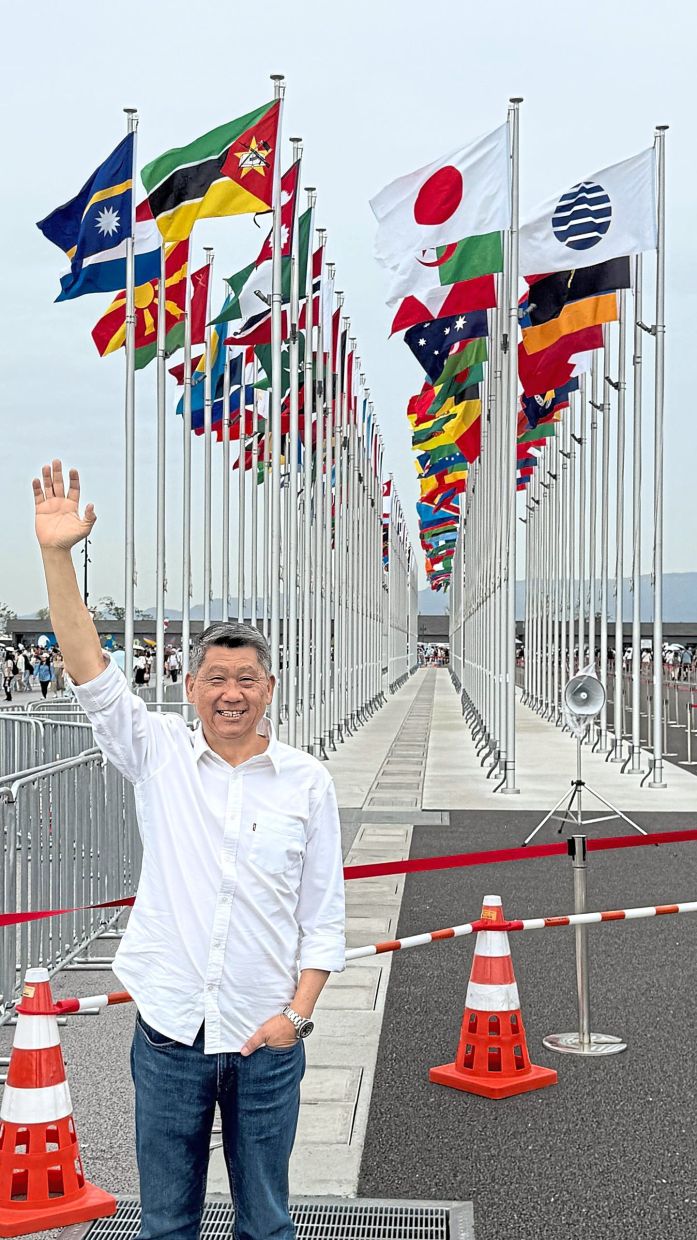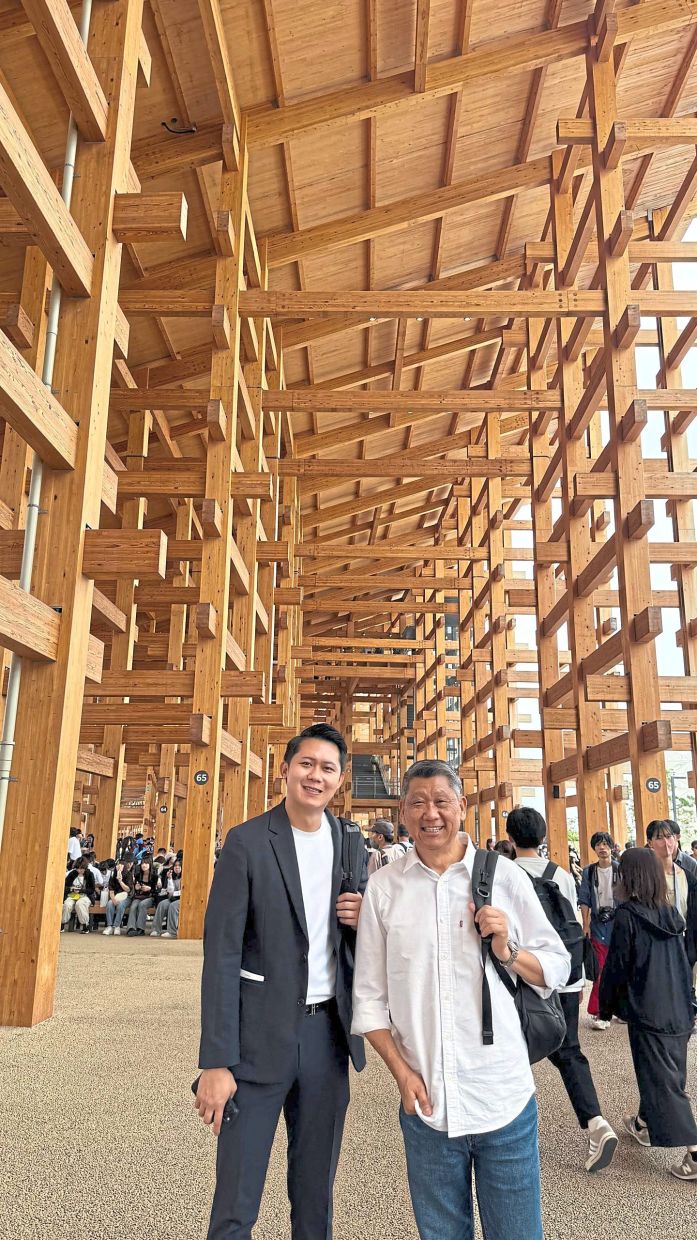The Japan Pavilion’s exhibition illustrate a future vision focusing on humanity, health and sustainable living. — Photos: LEESAN
Imagine packing the creativity and brilliance of 180 countries and regions into a mere 1.15sq km of land ... it’s no small feat for sure.
Welcome to the Osaka Expo 2025. It is held on the Yumeshima Island, an artificial island in Osaka Bay in Japan. Known as the “island of the future”, this is where the world has been distilled into one dazzling showcase.
The World Expo series began in 1851 in London, England, with the debut of the Great Exhibition of the Works of Industry of All Nations at the Crystal Palace. It was where humanity first displayed the fruits of the Industrial Revolution like the telegraph, steam engine, giant machines.
Back then, the aeroplane was not even invented yet, but many people were already asking the same timeless question: “What will the future look like?”
Since then, the World Expo has stood alongside the Olympics as one of humanity’s greatest global events – but instead of competition, it’s a marketplace of ideas, a laboratory of civilisation, and a theatre of imagination.
Fast forward to 174 years later, and the World Expo still circles back to the same question and focus: The Future.
In 1970, Osaka hosted Asia’s first-ever World Expo, drawing a mind-blowing 68 million visitors, a record still unmatched today.
Fifty-five years later Osaka again leads the world’s celebration of humanity – but in a vastly different era, one shadowed by wars, power struggles, and global distrust. In such times, can humanity still talk about “coexistence and shared prosperity”?
Perhaps that’s Osaka Expo’s real big question.
Now, as the six-month-long expo enters its final countdown (it ends on Oct 13), the site welcomes 300,000 visitors a day. The place feels like a boiling pot of ramen – hot, crowded, but full of joy. Everyone’s smiling. This is Japanese-style festivity at its best.
On Oct 3, I joined the crowd, happily squeezing, queuing, sweating, and loving every moment. As the expo is help once every five years, I felt it was worth every drop of my sweat.
By 11am the gates were packed with people. Within an hour after opening, the Luxembourg Pavilion already showed a 240-minute wait for visitors, and there were 179 more pavilions to check out!
Everywhere you went, you were required to line up – at each pavilion, at the stalls to buy food or drinks, and of course, at the toilets. Yet, miraculously, amid the sea of people everything remained in perfect order. No one cut line, no one quarrelled, and the toilets were always clean.
That’s Japan, I suppose, as I began to realise that the Japanese devotion to “order” runs deeper than religion.
Every World Expo revolves around the future. This year’s theme in Osaka, “Designing Future Society for Our Lives”, centres on regeneration, health, and happiness. It sounds United Nations-esque, and indeed it is. It invites us to ponder: In the an age of AI revolutions, climate anxiety, and human disconnection, how do we rebuild the bond between humanity and the planet?
Of course, the average citizen probably doesn’t spend their days worrying about the fate of the planet, beyond recycling or renewable energy talk. Even United States President Donald Trump once dismissed global warming as “fake news” and stormed out of a Kyoto Protocol meet.
But back to Osaka. Guided by Sayaka Yamagami, my interpreter who was specially arranged for me by the Japan National Tourism Organisation, I toured the Japan Pavilion, US Pavilion, Saudi Pavilion, and several corporate exhibits. Each one was like a mini-theatre of the future.
The Japan Pavilion embodied the elegance of simplicity – light and wood intertwining under the themes “Saving Lives”, “Empowering Lives”, and “Connecting Lives”, painting a “human-centred and sustainable” future.
The US Pavilion featured a giant screen of Trump waving (yes, seriously), alongside exhibits on AI and space tech.
The Saudi Pavilion, wrapped in a shimmering, sand-like facade – a desert mirage-turned-architecture – became one of the expo’s breakout stars.
Every Expo has its iconic building: Paris (France) had the Eiffel Tower, Brussels (Belgium) the Atomium, Shanghai the China Pavilion.
And for Osaka 2025, the soul lies in architect Sou Fujimoto’s creation of the Grand Ring, the world’s largest wooden structure.That’s what I really came for.
Stretching 2.1km around the site, the ring floats like a band of light, blending Edo-era craftsmanship with futuristic minimalism. It’s more than architecture – it’s a symbol. A reminder that in an age of AI and climate crises, humanity still needs wisdom and design to create a warm, hopeful society. As the saying goes, never forget your original intention.
One of the joys of the expo is seeing how each country speaks through architecture. The China Pavilion is fascinating as it seamlessly blends cultural elements like bamboo, Chinese characters and scrolls. By reinterpreting the ancient medium of bamboo slips through the lens of today’s information age, it tells the story of China’s millennia-old civilisation while expressing the nation’s vision of ecological harmony and a green future.
Saudi Arabia shipped real desert bricks from home. Nepal built a crimson temple; Australia, an eco-spiral; South Korea went full sci-fi with a pavilion covered in LED panels. Every one of them is a national business card ... and a selfie magnet.
Of course, what would global friendship be without food? You can find Germany’s sausages and wheat beer, French croissants, Swiss cheese, American burgers – their aromas pull you into the lines like a cartoon character floating while following a heady scent.
And yes, I hunted down a taste of Malaysia. At the Malaysia Pavilion, a Penang chef was flipping roti canai high in the air – that familiar rhythm of stretch, slap and toss made me instantly hungry. Except each “flying roti” cost RM52 and required an 80-minute wait! They said they sell over 2,000 pieces a day.
Watching Japanese, French, and Mexican visitors lining up for roti canai, I thought, “This isn’t just food. It’s culinary diplomacy, soft power at its most delicious.”
The World Expo has always been a showcase for human innovation. Many inventions that changed our lives debuted here: The lift (1854), telephone (1876), Coca-Cola (1886), and colour TV (1964).
Today, the spotlight shifted to AI, renewable energy, health tech, and sustainable living. At the Japan Pavilion, I truly felt what it means to sketch “a luminous blueprint for the future of life”. Japan is boldly leading the discussion on humanity’s next chapter.
At its heart, the expo’s magic lies in this simple truth: With one ticket, you can travel the world in a single day.
You see how every culture imagines the future, and feel that shared human spark of curiosity and hope. In that crowd, you believe that if we keep talking, dreaming, and creating, the world can, indeed, be better.
In the end, Osaka Expo 2025 mirrors Japan itself, not noisy, but quietly astonishing in its pursuit of order and perfection.
See you at the next one – Saudi Expo 2030 – where humanity will once again gather to ask that timeless question: “What will the future be?”
The views expressed here are entirely the writer’s own.
Leesan, the globe-trotting traveller who has visited seven continents and 151 countries, enjoys sharing his travel stories and insights. He has also authored six books.








